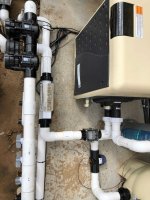- May 31, 2022
- 684
- Pool Size
- 8000
- Surface
- Plaster
- Chlorine
- Salt Water Generator
- SWG Type
- Pentair Intellichlor IC-20
I've been using a Hasa Liquid Feeder to meter liquid chorine into my pool. Works great, no issues.
But now its tank is cracked. And I see from other posts that this is a known defect, and that Hasa is providing the excellent customer service that they're known for and replacing tanks free of charge. But as long as I have to mess with my chlorination anyway, I'm thinking about switching to a SWG.
I have questions:
But now its tank is cracked. And I see from other posts that this is a known defect, and that Hasa is providing the excellent customer service that they're known for and replacing tanks free of charge. But as long as I have to mess with my chlorination anyway, I'm thinking about switching to a SWG.
I have questions:
- I gather that running the cell at 100% shortens its life. But is everything linear at lower duty cycles? That is, will an IC60 at 20% last for three times as many calendar days as an IC20 at 60%?
- My automation is a Pentair EasyTouch. Should (or must) my SWG also be from Pentair? If not, is there a recommended brand?
- My pool is open year-round, and the water temperature is below 60F for 4-5 months. Will I need to chlorinate with LC during that time?
- Is it an easy DIY install? Do I need anything (check valve, etc) other than the cell and controller?
- Does it matter (for warranty or other reasons) where I buy the thing?
- Any questions I should have asked but didn't?
Last edited:



